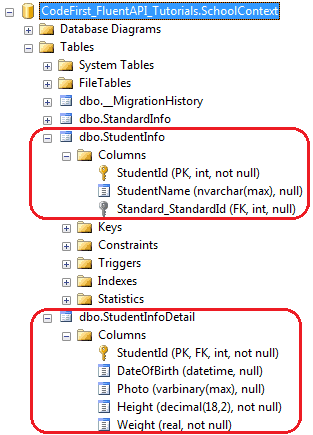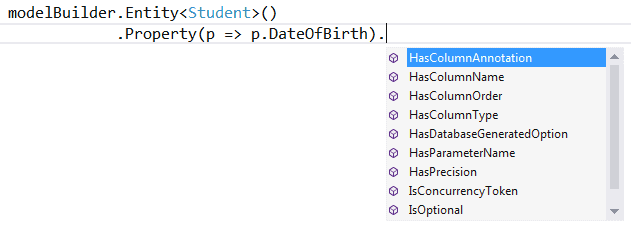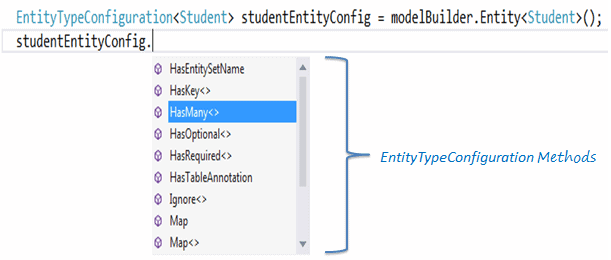EntityFramework Code-First 简易教程(七)-------领域类配置之Fluent API
Fluent API配置:
前面我们已经了解到使用DataAnotations特性来覆写Code-First默认约定,现在我们来学习Fluent API。
Fluent API是另一种配置领域类的方法,它比DataAnnotations特性提供更多的配置方法,下表是Fluent API支持的类型映射。
| 映射种类 | 配置数据库 |
|---|---|
| 模型(Model-wide)映射 |
|
| 实体(Entity)映射 |
|
| 属性(Property)映射 |
|
下面,我们开始使用Fluent API来配置领域类。
我们首先创建Student和Standard两个领域类,同样也创建出DbContext类,DbContext类中有个OnModelCreating方法,这里我们在它的继承类中把它覆写出来。
代码如下:
public class SchoolContext: DbContext
{
public SchoolDBContext(): base()
{
} public DbSet<Student> Students { get; set; }
public DbSet<Standard> Standards { get; set; } protected override void OnModelCreating(DbModelBuilder modelBuilder)
{
//Configure domain classes using modelBuilder here base.OnModelCreating(modelBuilder);
}
}
使用Fluent API配置领域类时,所有的配置代码都要写在OnModelCreating方法里面,所有的领域类都可以在这个方法里面写上他们的初始化代码。程序初始化的时候,DataAnnotation和Fluent API的优先级是:Fluent API > DataAnnotations > 默认约定。
DbModelBuilder类包含了重要的用于配置的属性和方法,更多详情请翻阅MSDN文档。
接下来我们详细讲一些常用的Fluent API配置方法。
一、EntityTypeConfiguration类:
EntityTypeConfiguration类在Fluent API中有着重要的作用,它提供了一系列重要的方法和属性来覆写默认约定。
EntityTypeConfiguration类可以运行DbModelBuilder类的Entity<TEntity>()方法获得,如下所示:
EntityTypeConfiguration有下面这些重要的方法:
| 方法名 | 返回类型 | 描述 |
|---|---|---|
| HasKey<TKey> | EntityTypeConfiguration | 为这个实体类型配置主键 |
| HasMany<TTargetEntity> | ManyNavigationPropertyConfiguration | 为实体类型配置多对多关系 |
| HasOptional<TTargetEntity> | OptionalNavigationPropertyConfiguration |
为实体类配置可选关系。没有指定关系的实体类型的实例会被存入数据库。数据库里外键可为空(nullable)。 |
| HasRequired<TTargetEntity> | RequiredNavigationPropertyConfiguration |
为实体类型配置必须关系。除非关系确定,否则实体类型的实例不能存入数据库。数据库中的外键将不能为空(non-nullable)。 |
| Ignore<TProperty> | Void |
从模型中排除一个属性,这个属性将不会映射到数据库。 |
| Map | EntityTypeConfiguration |
允许高级配置有关该实体类型映射到数据库模式。 |
| Property<T> | StructuralTypeConfiguration |
配置一个定义了这种类型的结构属性 |
| ToTable | Void |
配置实体类型映射的表名 |
可以访问MSDN查询更多关于 EntityTypeConfiguration 类的信息。
下面介绍怎么用Fluent API配置实体类
二、Entity Mappings:
我们继续使用在学校应用里面的Student和Standard两个领域类
代码如下:
public class Student
{
public Student()
{ }
public int StudentID { get; set; }
public string StudentName { get; set; }
public DateTime? DateOfBirth { get; set; }
public byte[] Photo { get; set; }
public decimal Height { get; set; }
public float Weight { get; set; } public Standard Standard { get; set; }
} public class Standard
{
public Standard()
{ }
public int StandardId { get; set; }
public string StandardName { get; set; } public ICollection<Student> Students { get; set; } }
}
配置默认架构:
当我们想为一组特殊的表设置一个不同的构架时,可以使用HasDefaultSchema方法:
public class SchoolContext: DbContext
{
public SchoolDBContext(): base()
{
} public DbSet<Student> Students { get; set; }
public DbSet<Standard> Standards { get; set; } protected override void OnModelCreating(DbModelBuilder modelBuilder)
{
//Configure default schema
modelBuilder.HasDefaultSchema("Admin");
}
}
映射实体到表:
Code-First将会为context类中的所有DbSet属性创建数据库表,表名就是属性名,比如上面的Students和Standards。我们也可以给表配置一个不同于DbSet属性名的表名,如下代码所示:
namespace CodeFirst_FluentAPI_Tutorials
{ public class SchoolContext: DbContext
{
public SchoolDBContext(): base()
{
} public DbSet<Student> Students { get; set; }
public DbSet<Standard> Standards { get; set; } protected override void OnModelCreating(DbModelBuilder modelBuilder)
{
//Configure default schema
modelBuilder.HasDefaultSchema("Admin"); //Map entity to table
modelBuilder.Entity<Student>().ToTable("StudentInfo");
modelBuilder.Entity<Standard>().ToTable("StandardInfo","dbo"); }
}
}
如上代码,我们配置表名的ToTable方法是接在Entity<TEntity>()方法后面,上面代码已经把映射Student实体的表名改成StudentInfo,把映射Standard实体的表名改成了StandardInfo,特别留意的是,虽然我们把默认的架构名改成了Admin,但是Standard实体又特别指定了dbo架构,所以生成的数据库如下所示:

映射实体到多张表:
下面的代码演示了怎样把Student实体映射到数据库的多张表:
namespace CodeFirst_FluentAPI_Tutorials
{ public class SchoolContext: DbContext
{
public SchoolDBContext(): base()
{
} public DbSet<Student> Students { get; set; }
public DbSet<Standard> Standards { get; set; } protected override void OnModelCreating(DbModelBuilder modelBuilder)
{
modelBuilder.Entity<Student>().Map(m =>
{
m.Properties(p => new { p.StudentId, p.StudentName});
m.ToTable("StudentInfo"); }).Map(m => {
m.Properties(p => new { p.StudentId, p.Height, p.Weight, p.Photo, p.DateOfBirth});
m.ToTable("StudentInfoDetail"); }); modelBuilder.Entity<Standard>().ToTable("StandardInfo"); }
}
}
如上所示,使用Map()方法可以映射Student实体的一些属性到StudentInfo表中,另一些属性到StudentInfoDetail表中,我们把Student实体分裂成了两张表,生成的数据库如下所示:

Map method need the delegate method as a parameter. You can pass or in Map method, as shown below.
Map方法的传入参数是一个委托,具体可以参考 Action delegate 和 lambda expression。
完成代码如下:
using System.Data.Entity.ModelConfiguration.Configuration; namespace CodeFirst_FluentAPI_Tutorials
{ public class SchoolContext: DbContext
{
public SchoolDBContext(): base()
{
} public DbSet<Student> Students { get; set; }
public DbSet<Standard> Standards { get; set; } protected override void OnModelCreating(DbModelBuilder modelBuilder)
{
modelBuilder.Entity<Student>().Map(delegate(EntityMappingConfiguration<Student> studentConfig)
{
studentConfig.Properties(p => new { p.StudentId, p.StudentName });
studentConfig.ToTable("StudentInfo");
}); Action<EntityMappingConfiguration<Student>> studentMapping = m =>
{
m.Properties(p => new { p.StudentId, p.Height, p.Weight, p.Photo, p.DateOfBirth });
m.ToTable("StudentInfoDetail");
};
modelBuilder.Entity<Student>().Map(studentMapping); modelBuilder.Entity<Standard>().ToTable("StandardInfo"); }
}
}
三、Property Mappings:
下面我们来介绍怎样用Fluent API配置实体类的属性
我们仍然使用学校的例子,如下两个Student和Standard领域类:
public class Student
{
public Student()
{ }
public int StudentKey { get; set; }
public string StudentName { get; set; }
public DateTime DateOfBirth { get; set; }
public byte[] Photo { get; set; }
public decimal Height { get; set; }
public float Weight { get; set; } public Standard Standard { get; set; }
} public class Standard
{
public Standard()
{ }
public int StandardKey { get; set; }
public string StandardName { get; set; } public ICollection<Student> Students { get; set; } }
}
配置主键和混合主键:
上面的两个领域类,不能依据Code-First默认约定生成主键,因为它们没有Id或者{类名}+Id的属性,所以这里使用EntityTypeConfiguration类里的HasHey()方法来创建主键。
注意,modelBuilder.Entity<TEntity>()返回的是EntityTypeConfiguration对象。
public class SchoolContext: DbContext
{
public SchoolDBContext(): base()
{
} public DbSet<Student> Students { get; set; }
public DbSet<Standard> Standards { get; set; } protected override void OnModelCreating(DbModelBuilder modelBuilder)
{
//Configure primary key
modelBuilder.Entity<Student>().HasKey<int>(s => s.StudentKey);
modelBuilder.Entity<Standard>().HasKey<int>(s => s.StandardKey); //Configure composite primary key
modelBuilder.Entity<Student>().HasKey<int>(s => new { s.StudentKey, s.StudentName });
}
}
配置列名、数据类型和排序:
Code-First默认约定以属性名为列名,下面的代码覆写了这一约定:
public class SchoolContext: DbContext
{
public SchoolDBContext(): base()
{
} public DbSet<Student> Students { get; set; }
public DbSet<Standard> Standards { get; set; } protected override void OnModelCreating(DbModelBuilder modelBuilder)
{
//Configure Column
modelBuilder.Entity<Student>()
.Property(p => p.DateOfBirth)
.HasColumnName("DoB")
.HasColumnOrder()
.HasColumnType("datetime2");
}
}
如上所示,我们使用一个实体的Property()方法来配置列名、排序和数据类型
modelBuilder.Entity<TEntity>().Property(expression) 可以使用不同的方法来配置特别的属性,如下图所示:

为属性配置可空或不为空的列:
Code-First将为主键的数据类型创建一个不为空的值,因为主键本身就不能为空,除非它的属性上使用了?号或者标记了Nullable<T>。
使用IsOptional方法可以创建一个可为空的列,同样,使用IsRequired也可以创建一个不为空的列。
namespace CodeFirst_FluentAPI_Tutorials
{ public class SchoolContext: DbContext
{
public SchoolDBContext(): base()
{
} public DbSet<Student> Students { get; set; }
public DbSet<Standard> Standards { get; set; } protected override void OnModelCreating(DbModelBuilder modelBuilder)
{
//Configure Null Column
modelBuilder.Entity<Student>()
.Property(p => p.Heigth)
.IsOptional(); //Configure NotNull Column
modelBuilder.Entity<Student>()
.Property(p => p.Weight)
.IsRequired();
}
}
}
配置列的大小:
Code-First默认约定是给列创建最大的数据类型大小,用HasMaxLength()方法覆写之。
namespace CodeFirst_FluentAPI_Tutorials
{ public class SchoolContext: DbContext
{
public SchoolDBContext(): base()
{
} public DbSet<Student> Students { get; set; }
public DbSet<Standard> Standards { get; set; } protected override void OnModelCreating(DbModelBuilder modelBuilder)
{
//Set StudentName column size to 50
modelBuilder.Entity<Student>()
.Property(p => p.StudentName)
.HasMaxLength(); //Set StudentName column size to 50 and change datatype to nchar
//IsFixedLength() change datatype from nvarchar to nchar
modelBuilder.Entity<Student>()
.Property(p => p.StudentName)
.HasMaxLength().IsFixedLength(); //Set size decimal(2,2)
modelBuilder.Entity<Student>()
.Property(p => p.Height)
.HasPrecision(, );
}
}
}
IsFixedLength方法把列的类型从nvarchar转变为nchar,HasPrecision方法改变了数据类型为decimal列的精度。
配置并发列:
使用ConcurrencyToken方法把一个属性设置为并发列,代码如下:
namespace CodeFirst_FluentAPI_Tutorials
{ public class SchoolContext: DbContext
{
public SchoolDBContext(): base()
{
} public DbSet<Student> Students { get; set; }
public DbSet<Standard> Standards { get; set; } protected override void OnModelCreating(DbModelBuilder modelBuilder)
{
//Set StudentName as concurrency column
modelBuilder.Entity<Student>()
.Property(p => p.StudentName)
.IsConcurrencyToken();
}
}
}
如上代码所示,StudentName被设置成为了并发列,每当update和delete操作的时候都会把StudentName中的值加入到SQL语句中的"where"子句中。
对于byte[]类型的属性,我们也可以用IsRowVersion()方法来将其配置成并发列。
到此,Fluent API的主要内容就讲的差不多了,下面开始会讲一对一,一对多,多对多的领域类配置,和数据库迁移等。
EntityFramework Code-First 简易教程(七)-------领域类配置之Fluent API的更多相关文章
- EntityFramework Code-First 简易教程(六)-------领域类配置之DataAnnotations
EF Code-First提供了一个可以用在领域类或其属性上的DataAnnotation特性集合,DataAnnotation特性会覆盖默认的EF约定. DataAnnotation存在于两个命名空 ...
- EntityFramework Code-First 简易教程(五)-------领域类配置
前言:在前篇中,总是把领域类(Domain Class)翻译成模型类,因为我的理解它就是一个现实对象的抽象模型,不知道对不对.以防止将来可能的歧义,这篇开始还是直接对Domain Class直译. 前 ...
- Entity Frame Code First 简易教程
简介 什么是ORM 搭建Entity FrameWork CodeFirst应用 数据库迁移 表属性常见配置 Entity FrameWork 一对多.多对多 一.简介 Entity Framewor ...
- EntityFramework Code-First—领域类配置之DataAnnotations
本文出自:https://www.cnblogs.com/tang-tang/p/5510574.html 一.摘要 EF Code-First提供了一个可以用在领域类或其属性上的DataAnnota ...
- WebGL简易教程(七):绘制一个矩形体
目录 1. 概述 2. 示例 2.1. 顶点索引绘制 2.2. MVP矩阵设置 2.2.1. 模型矩阵 2.2.2. 投影矩阵 2.2.3. 视图矩阵 2.2.4. MVP矩阵 3. 结果 4. 参考 ...
- Spring Boot2 系列教程(七)理解自动化配置的原理
Spring Boot 中的自动化配置确实够吸引人,甚至有人说 Spring Boot 让 Java 又一次焕发了生机,这话虽然听着有点夸张,但是不可否认的是,曾经臃肿繁琐的 Spring 配置确实让 ...
- EntityFramework Code-First 简易教程(十一)-------从已存在的数据库中映射出表
怎样从一个已存在的数据库中映射表到 entity 实体? Entity Framework 提供了一个简便方法,可以为已存在的数据库里的所有表和视图创建实体类(entity class),并且可以用 ...
- Dart 语言简易教程系列
google Fuchsia系统 及 dart语言简介 在 InteIIiJ IDEA 中搭建 Dart 的开发环境 Dart Linux 开发环境搭建 Dart 语言简易教程(一) Dart 语言简 ...
- EntityFramework 系列:实体类配置-根据依赖配置关系和关联
EF实体类的配置可以使用数据注释或Fluent API两种方式配置,Fluent API配置的关键在于搞清实体类的依赖关系,按此方法配置,快速高效合理.为了方便理解,我们使用简化的实体A和B以及A.B ...
随机推荐
- 【sping揭秘】17、@Around,@Introduction
package cn.cutter.start.bean; import org.apache.commons.logging.Log; import org.apache.commons.loggi ...
- gulp和grunt 分享ppt
gulp是前端开发过程中对代码进行构建的工具,是自动化项目的构建利器:她不仅能对网站资源进行优化,而且在开发过程中很多重复的任务能够使用正确的工具自动完成:使用她,我们不仅可以很愉快的编写代码,而且大 ...
- Java NIO中的通道Channel(一)通道基础
什么是通道Channel 这个说实话挺难定义的,有点抽象,不过我们可以根据它的用途来理解: 通道主要用于传输数据,从缓冲区的一侧传到另一侧的实体(如文件.套接字...),反之亦然: 通道是访问IO服务 ...
- postman自定义函数实现 时间函数
一:主要内容 postman环境变量方式封装格式化日期函数:yyyy-MM-dd HH:mm:ss postman利用moment模块实现格式化日期函数:yyyy-MM-dd HH:mm:ss 二:p ...
- Java可以像Python一样方便爬去世间万物
前言: 之前在大二的时候,接触到了Python语言,主要是接触Python爬虫那一块 比如我们常用的requests,re,beautifulsoup库等等 当时为了清理数据和效率,还专门学了正则表达 ...
- [POI2004] SZN
Description 给定\(N(N\leq 10000)\)个点的树,要求用最少的路径覆盖树边.路径之间可以有交点,不能有交边.问最少需要几条路径以及在第一问的基础上最长的路径最短是多少? Sol ...
- ef学习一
学习内容:https://www.cnblogs.com/5ishare/p/5801229.html 注意点: 1.NuGet程序包引入ef,使用DbSet<>必须引入ef.本例EFCo ...
- int和Integer有什么区别?
Java提供两种不同的类型:引用类型和原始类型(或内置类型): int是Java的原始数据类型,Integer是java为int提供的封装类. java为每个原始类型提供了封装类: 原始类型:bool ...
- 在EF中执行SQL语句(转载)
在EF中执行SQL语句 你可能要问,我用EF不就为了避免写SQL吗?如果要写SQL我不如直接用ADO.NET得了.话虽然这么说没错,可有些时候使用EF操作数据还是有一些不方便,例如让你根据条件删除 ...
- Linux将未挂载的磁盘挂载到目录
1.找的未挂载磁盘fdisk -l2.格式化mkfs -t ext4 /dev/xvdc3.挂载目录mount /dev/xvdc /data4.开机启动vi /etc/fstab/dev/xvdc ...

